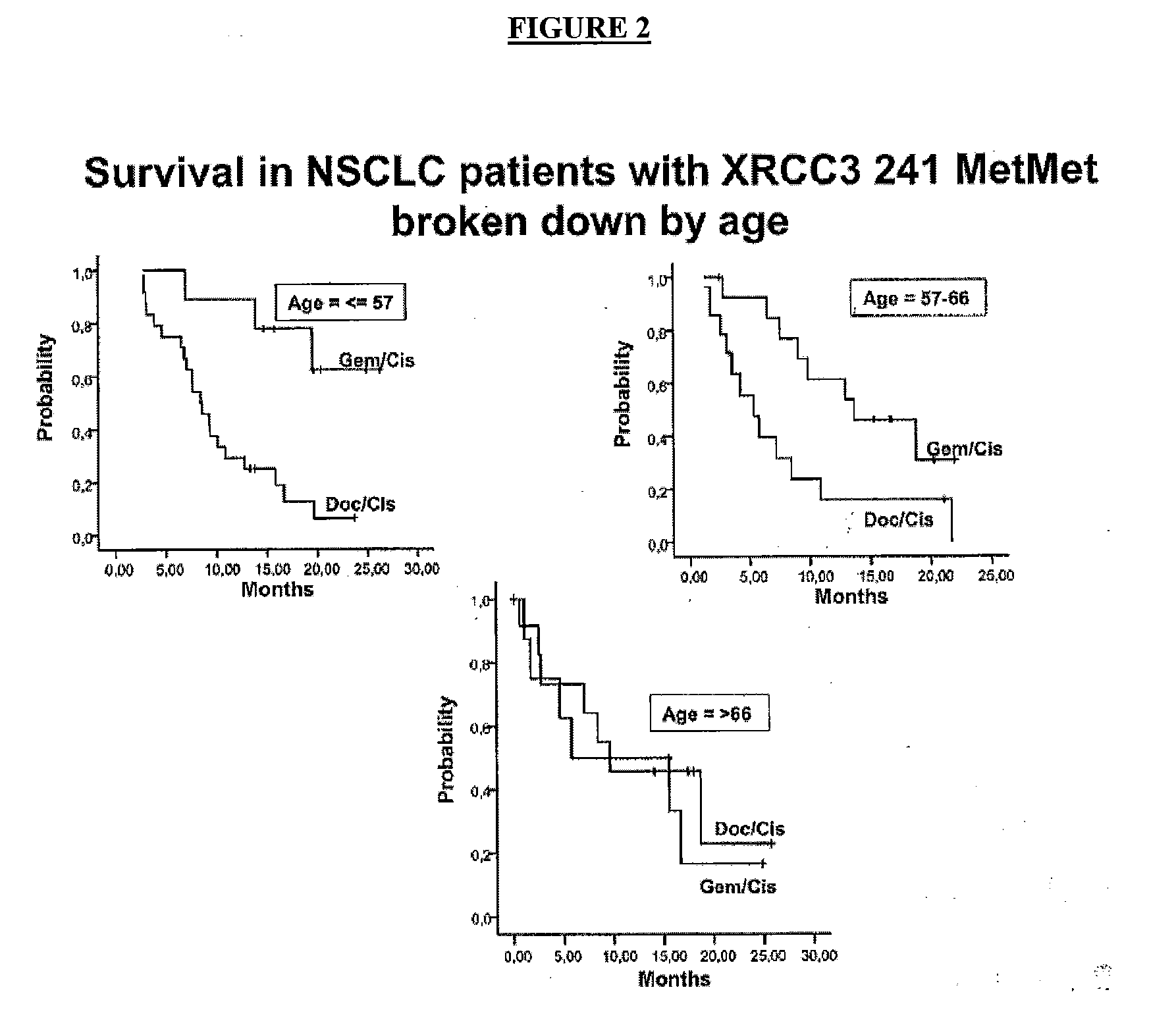Method of determining outcome of non small-cell lung cancer according to xrcc3 polymorphism
a non-small cell lung cancer and polymorphism technology, applied in the field of diagnosis, can solve the problems of affecting the survival rate, and affecting the curative potential of the cancer,
- Summary
- Abstract
- Description
- Claims
- Application Information
AI Technical Summary
Benefits of technology
Problems solved by technology
Method used
Image
Examples
example 1
XRCC3 241 MetMet is Associated with Longer Survival in cisplatin-gemcitabine-treated NSCL Cancer Patients
[0058]The inventors assessed polymorphisms in the peripheral blood of stage IV non-small-cell lung cancer patients and correlated genotypes with survival. The study was approved by the independent ethics committees of all participating centers, and all patients gave their signed informed consent.
Methodology
Subjects
[0059]Patients were included in a Spanish Lung Cancer Group multicenter clinical trial. Patients were considered eligible if they had stage IV or stage IIIB (with malignant pleural effusion) histologically confirmed non-small-cell lung cancer. Other eligibility criteria included an Eastern Cooperative Oncology Group performance status of 0 (asymptomatic and fully active) or 1 (symptomatic, fully ambulatory, restricted in physically strenuous activity); age of at least 18 years; adequate hematologic function (hemoglobin at least 9 g per deciliter [5.6 mmol per liter], n...
example 2
[0075]Following the procedures described in example 1, a total of 651 stage IV NSCLC patients receiving docetaxel (Taxotere) plus cisplatin (474 patients) or gemcitabine plus cisplatin (177) were evaluated. The characteristics of the patients are summarised in table 3:
Doc / CisGem / CisN (%)N (%)pNo Patients474177Age0.01Median59.7 62Range30.6–79.531–82Sex0.001Male396 (83.5)165 (93.2) Female 78 (16.5)12 (6.8) PS0.840131 (27.6)47 (26.6)1343 (72.4)130 (73.4) Histology0.06Adeno239 (50.9)75 (42.6)SCC147 (31.3)73 (41.5)LCC 84 (17.9)28 (15.9)Stage0.35IIIB 73 (15.4)22 (12.4)IV401 (84.6)155 (87.6) Surgery (yes)42 (8.9)16 (9) 0.99Radiotherapy38 (8) 14 (7.9) 0.99(yes)
[0076]The distribution of the genotypes found in stage IV NSCLC patients are shown in table 4, distributed according to the chemotherapy given to them:
PolymorphismGenotypic frequencies p (%)XRCC3 T241MThrThrThrMetMetMetDocetaxel / cis125 (35.8)173 (49.6)51 (14.6)Gemcitabine / cis65 (38) 75 (43.9)31 (18.1)
[0077]Overall median survival (...
example 3
[0078]Following the procedure explained in example 1, real-time PCR assay was used to determine XRCC3 genotype from DNA isolated from baseline blood samples of 878 stage IV Non Small Cell Lung Cancer patients (162 treated with gemcitabine / cisplatin; 716 with docetaxel / cisplatin). The patient characteristics are as follows: median age, 60; 266 patients (30%) 66. Adenocarcinoma: 459 patients (53%).
[0079]Homozygous variant XRCC3 241 MetMet was found in 124 patients (14%), with the same frequency in each of the three age groups.
[0080]After a median follow-up of 7.6 months (95% CT, 1-47 months), overall median survival (MS) was 9.5 months (95% CI, 8.8-10.2 m), with no differences between the 2 regimens.
[0081]In all patients with XRCC3 241 MetMet, Median Survival was 12.9 months for patients treated with gemcitabine / cisplatin and 8.4 months for patients treated with docetaxel / cisplatin (P=0.06) (hazard ratio at 2 y=0.23). In patients with XRCC3 241 MetMet and under 55 years of age, Median...
PUM
| Property | Measurement | Unit |
|---|---|---|
| Time | aaaaa | aaaaa |
| Fraction | aaaaa | aaaaa |
| Fraction | aaaaa | aaaaa |
Abstract
Description
Claims
Application Information
 Login to View More
Login to View More - R&D
- Intellectual Property
- Life Sciences
- Materials
- Tech Scout
- Unparalleled Data Quality
- Higher Quality Content
- 60% Fewer Hallucinations
Browse by: Latest US Patents, China's latest patents, Technical Efficacy Thesaurus, Application Domain, Technology Topic, Popular Technical Reports.
© 2025 PatSnap. All rights reserved.Legal|Privacy policy|Modern Slavery Act Transparency Statement|Sitemap|About US| Contact US: help@patsnap.com


